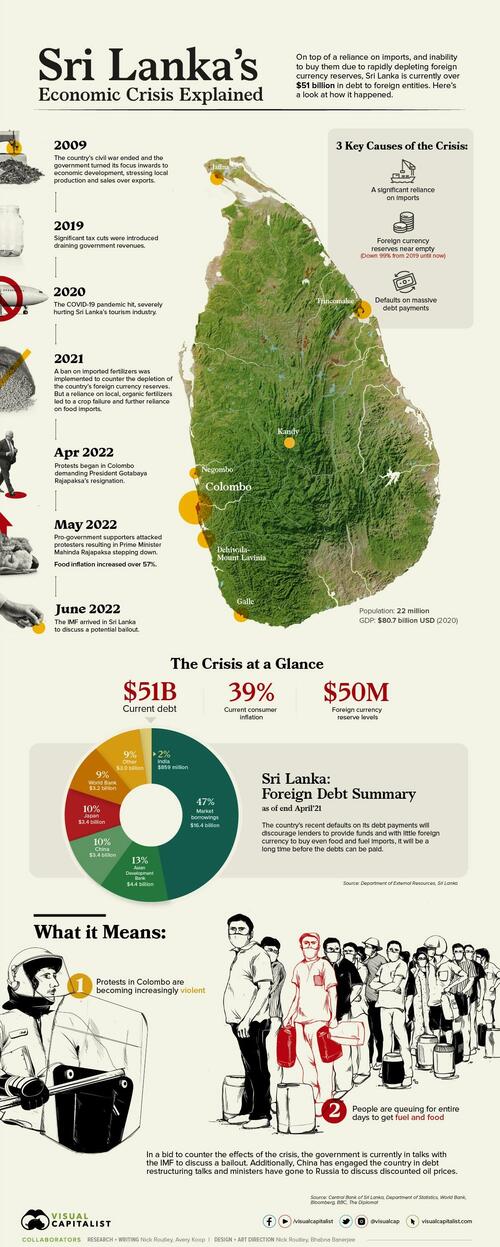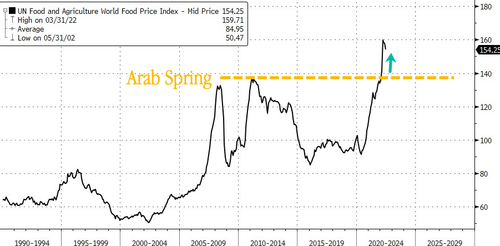What’s happening in Sri Lanka ?? is going to be happening in many other places around the world soon.
— Luke Rudkowski (@Lukewearechange) July 9, 2022
Thousands of protesters stormed Sri Lankan President Gotabaya Rajapaksa’s official residence as part of an anti-government demonstration calling for his resignation following the country’s economic collapse.
Demonstrators marched to Sri Lanka’s commercial capital of Colombo early Saturday. They jumped security fences surrounding the residence and overran the president’s security forces. Rajapaksa was evacuated from the palace around 1000 local time, his secretary Gamini Senarath told Bloomberg.
Our Entire Civilization Is Structured Around Keeping Us From Realizing We Can Do This
"The video footage coming out of Sri Lanka right now has been the recurring nightmare of every ruler throughout history."https://t.co/odTc07ufQF
— Caitlin Johnstone ? (@caitoz) July 9, 2022
“The president was escorted to safety,” a senior defense source told AFP. “He is still the president, he is being protected by a military unit.”
Alleged footage of the president fleeing on a naval ship.
?? BREAKING NEWS??
Footage emerges said to be of President Rajapakse fleeing Sri Lanka aboard a Navy Vessel. pic.twitter.com/yvaYv5uGvB
— UNN (@UnityNewsNet) July 9, 2022
Footage uploaded to social media platforms from the president’s residence shows thousands of protesters surrounding the palace and then charging inside.
Colombo, Sri Lanka right now. The Presidential Palace has been stormed, President Gotabaya Rajapaksa is said to have fled. Unbelievable scenes. Live reports on @IndiaToday: https://t.co/p6JV6FzCub pic.twitter.com/8zlJdBfN2P
— Shiv Aroor (@ShivAroor) July 9, 2022
BREAKING: Sri Lanka protestors have stormed the presidential palace pic.twitter.com/wMLTBymtot
— Insider Paper (@TheInsiderPaper) July 9, 2022
Protesters enjoying Sri Lanka’s absconding President’s swimming pool! No dictator should remain in illusion that the power is for ever, and when the end comes, it is always violent and nasty. pic.twitter.com/T3ePbkA0gM
— Ashok Swain (@ashoswai) July 9, 2022
?Breaking: Sri Lanka President Gotabaya Rajapaksa flees after he declared the nation as total bankrupt. The moment after that the citizens surrounded the presidential palace and waived black flag along with Sri Lankan??. There are no news yet on the whereabouts of President. pic.twitter.com/PGyev8lFxs
— Real Mac Report (@RealMacReport) July 9, 2022
Protestors inside President's House #SriLanka #SriLankaProtests pic.twitter.com/c1waEZ5zMM
— Jamila Husain (@Jamz5251) July 9, 2022
Prime Minister Ranil Wickremesinghe held emergency talks with party leaders before the parliament speaker during the unrest to decide what was next in resolving the worsening socio-economic crisis in the country of 22 million people.
Lawmakers asked Rajapaksa to relinquish his power to allow a new leader with a parliament majority to regain control and find a swift resolution to high inflation and shortages that have angered people for months.
The debt-laden economy of the tiny South Asian nation has “completely collapsed” as it lacks foreign exchange reserves to import essential items such as food and fuel. Shortages have materialized as the government began rationing goods last month.
Even though the government has held talks with the IMF, India, China, and Japan for new credit lines and even spoke with Russia about purchasing heavily discounted crude, the country entered a terminal phase where social unrest is spiraling out of control.
Visual Capitalist’s Avery Koop details several reasons for this crisis and the economic turmoil has sparked unrest over the last several months. This visual breaks down some of the elements that led to Sri Lanka’s current situation.

The Sri Lankan crisis carries the potential for an Arab Spring-style eruption across other countries that could quickly morph into an “Everywhere Spring” as people worldwide are angered by high inflation and shortage of food and fuel. This eruption in unrest could eclipse the revolution seen in 2011 that spread across the Arabic-speaking world due to high food prices.
Everyone’s favorite permabear, SocGen’s Albert Edwards, first warned about the consequences of central banks injecting record amounts of money into the global economy in late 2020 and how it could spark soaring food prices, similar to 2011, where social unrest and revolutions were seen in many Arab countries.

Edwards’ prediction appears to be playing out. It could be much worse than a decade ago as much of the world experiences economic hardships and what some believe could be the emergence of stagflation.
Could the fall of Sri Lanka signal that weak, heavily indebted countries worldwide are about to fall like dominos?
Republished from ZeroHedge.com with permission










Sign up on lukeunfiltered.com or to check out our store on thebestpoliticalshirts.com.